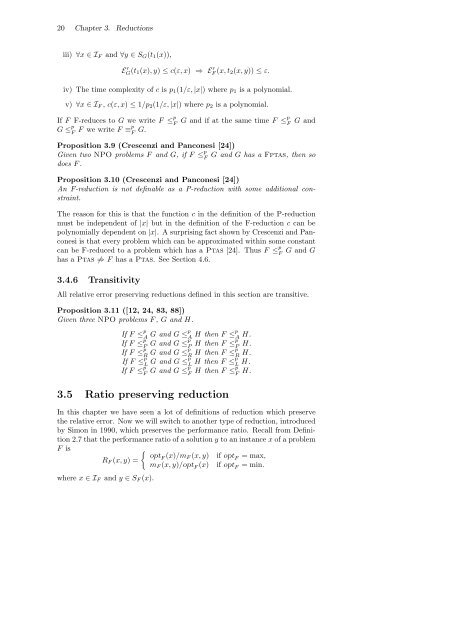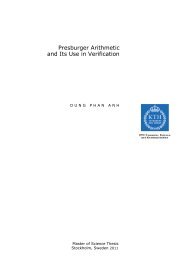On the Approximability of NP-complete Optimization Problems
On the Approximability of NP-complete Optimization Problems
On the Approximability of NP-complete Optimization Problems
Create successful ePaper yourself
Turn your PDF publications into a flip-book with our unique Google optimized e-Paper software.
20 Chapter 3. Reductions<br />
iii) ∀x ∈IF and ∀y ∈ SG(t1(x)),<br />
E r G (t1(x),y) ≤ c(ε, x) ⇒ E r F (x, t2(x, y)) ≤ ε.<br />
iv) The time complexity <strong>of</strong> c is p1(1/ε, |x|) wherep1 is a polynomial.<br />
v) ∀x ∈IF , c(ε, x) ≤ 1/p2(1/ε, |x|) wherep2 is a polynomial.<br />
If F F-reduces to G we write F ≤ p<br />
G ≤ p<br />
F<br />
F we write F ≡p<br />
F G.<br />
F<br />
G and if at <strong>the</strong> same time F ≤p<br />
F<br />
G and<br />
Proposition 3.9 (Crescenzi and Panconesi [24])<br />
Given two <strong>NP</strong>O problems F and G,if F ≤ p<br />
F G and G has a Fptas,<strong>the</strong>n so<br />
does F .<br />
Proposition 3.10 (Crescenzi and Panconesi [24])<br />
An F-reduction is not definable as a P-reduction with some additional constraint.<br />
The reason for this is that <strong>the</strong> function c in <strong>the</strong> definition <strong>of</strong> <strong>the</strong> P-reduction<br />
must be independent <strong>of</strong> |x| but in <strong>the</strong> definition <strong>of</strong> <strong>the</strong> F-reduction c can be<br />
polynomially dependent on |x|. A surprising fact shown by Crescenzi and Panconesi<br />
is that every problem which can be approximated within some constant<br />
can be F-reduced to a problem which has a Ptas [24]. Thus F ≤ p<br />
F G and G<br />
has a Ptas ⇒ F has a Ptas. See Section 4.6.<br />
3.4.6 Transitivity<br />
All relative error preserving reductions defined in this section are transitive.<br />
Proposition 3.11 ([12, 24, 83, 88])<br />
Given three <strong>NP</strong>O problems F , G and H.<br />
If F ≤ p<br />
A G and G ≤p<br />
A H <strong>the</strong>n F ≤p<br />
If F ≤ p<br />
P G and G ≤p<br />
P H <strong>the</strong>n F ≤p<br />
If F ≤ p<br />
R G and G ≤p<br />
R H <strong>the</strong>n F ≤p<br />
If F ≤ p<br />
G and G ≤p H <strong>the</strong>n F ≤p<br />
L<br />
If F ≤ p<br />
F<br />
L<br />
G and G ≤p<br />
F<br />
A H.<br />
P H.<br />
R H.<br />
L H.<br />
H <strong>the</strong>n F ≤p<br />
F H.<br />
3.5 Ratio preservingreduction<br />
In this chapter we have seen a lot <strong>of</strong> definitions <strong>of</strong> reduction which preserve<br />
<strong>the</strong> relative error. Now we will switch to ano<strong>the</strong>r type <strong>of</strong> reduction, introduced<br />
by Simon in 1990, which preserves <strong>the</strong> performance ratio. Recall from Definition<br />
2.7 that <strong>the</strong> performance ratio <strong>of</strong> a solution y to an instance x <strong>of</strong> a problem<br />
F is<br />
<br />
optF (x)/mF (x, y) if optF =max,<br />
RF (x, y) =<br />
mF (x, y)/optF (x) if optF =min.<br />
where x ∈IF and y ∈ SF (x).

















